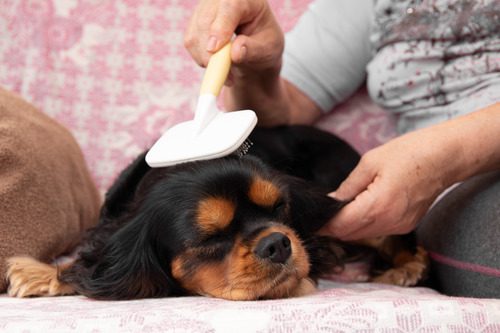Why Your Dog Has Dandruff
Noticing white flakes on your dog’s coat can be concerning, especially if your pet is scratching frequently. Many pet owners wonder, “Why does my dog have dandruff?” While dandruff in dogs is common, it often indicates an underlying issue that requires attention. The team at Schertz Animal Hospital is here to help you understand the causes of dandruff, so you’ll know when to seek veterinary care and help improve your dog’s comfort and skin health.

Understanding the Causes Behind Your Dog’s Flaky Skin
Dandruff in dogs occurs when dead skin cells shed excessively, creating visible flakes in their fur. This condition can stem from various factors, ranging from environmental conditions to underlying health issues. If you’re asking, “Why does my dog have dandruff?” here are some common causes:
Dry Skin Due to Weather Changes
Just like humans, dogs can experience dry skin in response to environmental factors. Cold weather and low humidity levels can strip moisture from your dog’s skin, leading to increased flaking. If your dog’s dandruff worsens in winter or after exposure to indoor heating, seasonal dryness could be the culprit.
Allergies and Skin Sensitivities
Allergies are a leading cause of dandruff in dogs. Environmental allergens such as pollen, dust, and mold can trigger skin reactions. Food allergies may also contribute to skin irritation and flaking. If your dog’s dandruff is accompanied by redness, itching, or frequent licking, allergies might be the root cause.
Poor Nutrition and Dietary Deficiencies
A balanced diet is essential for healthy skin and coat. Dogs that lack essential fatty acids, such as Omega-3 and Omega-6, are more likely to develop dandruff. If your pet’s diet is low in quality or lacks vital nutrients, their skin may become dry and flaky. Consulting a veterinarian about proper nutrition can help address this issue.
Parasites and Skin Conditions
External parasites, including fleas, mites, and lice, can cause skin irritation and excessive flaking. Cheyletiella mites, also known as “walking dandruff,” create dandruff-like symptoms by burrowing into the skin. If your dog has persistent dandruff along with excessive scratching, hair loss, or skin inflammation, a parasitic infestation may be the cause.
Underlying Medical Conditions
Certain medical conditions can lead to dandruff as a symptom. Some of the most common include:
- Seborrhea – A skin disorder that causes excessive oil production or dryness, leading to dandruff.
- Hypothyroidism – A hormonal imbalance that can make your dog’s skin dry and flaky.
- Cushing’s Disease – A condition that affects hormone regulation and may lead to skin problems.
If your dog’s dandruff is persistent and accompanied by other concerning symptoms like lethargy, weight changes, or hair loss, a veterinary visit is recommended.
Recognizing Symptoms That Warrant a Vet Visit
While mild dandruff may not be alarming, certain symptoms indicate a deeper issue requiring professional attention. If you’re wondering, “Why does my dog have dandruff, and should I be concerned?”, watch for these signs:
- Excessive scratching or biting at the skin
- Red, inflamed, or irritated skin
- Hair loss or patchy fur
- Foul odor coming from the skin
- Scabs, sores, or open wounds
If you notice any of these symptoms, contact Schertz Animal Hospital at (210) 659-0345 or request an appointment to determine the cause of your dog’s skin issues.
How Grooming and Hygiene Affect Your Dog’s Skin
Regular grooming plays a significant role in maintaining healthy skin and preventing dandruff. Proper hygiene practices can help reduce flaking and irritation.
Choosing the Right Shampoo
Using the right shampoo is crucial for your dog’s skin health. Harsh or heavily fragranced shampoos can strip natural oils, making the skin dry. Opt for gentle, moisturizing, or oatmeal-based shampoos formulated for dogs. If your pet has allergies or sensitive skin, a hypoallergenic shampoo may be beneficial.
Bathing Frequency Matters
Overbathing can contribute to dry skin, leading to dandruff. Most dogs only need a bath once every few weeks, depending on their breed, lifestyle, and skin condition. If your dog’s skin is prone to dryness, consider using a vet-approved moisturizing spray between baths.
Brushing to Distribute Natural Oils
Brushing your dog’s coat regularly helps distribute natural skin oils, keeping their coat hydrated and reducing dandruff buildup. Brushing also removes loose fur and debris, preventing irritation. Depending on your dog’s coat type, use a soft-bristle brush or deshedding tool to keep their skin in good condition.
Could Stress Be a Factor in Your Dog’s Dandruff?
Stress and anxiety can affect a dog’s overall health, including their skin. If your dog is experiencing changes in their environment, such as moving to a new home, introducing a new pet, or changes in routine, their body may respond with skin issues like dandruff. Dogs may show stress through excessive licking, scratching, or changes in appetite. Providing a stable routine, engaging in daily exercise, and offering interactive toys can help reduce stress-related dandruff.
When Should You Seek Veterinary Care for Persistent Dandruff?
If you’ve been asking, “Why does my dog have dandruff?” and the flakes persist despite proper care, it may be time to visit your veterinarian. Chronic dandruff could be a sign of an underlying health issue that requires medical attention. At Schertz Animal Hospital, our team can assess your dog’s skin health and recommend appropriate treatment options. Call us at (210) 659-0345 or request an appointment to help your pet feel more comfortable.
Recent Posts
About Us
We know that choosing the right veterinarian for your pet (and you) can be a challenge. Yet, with our stress-free handling, our long-term, experienced staff, and a state-of-the-art facility, we make the decision an easy one!
